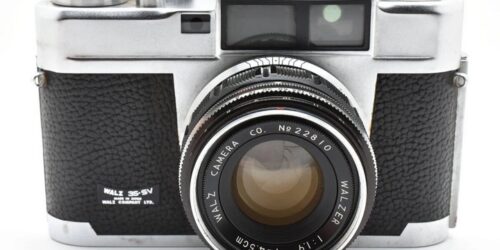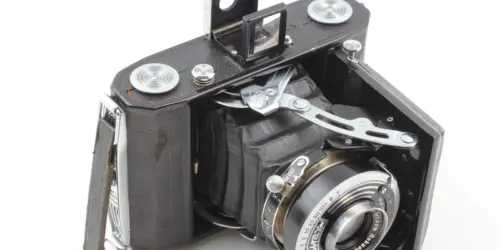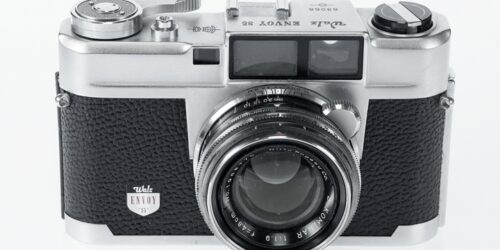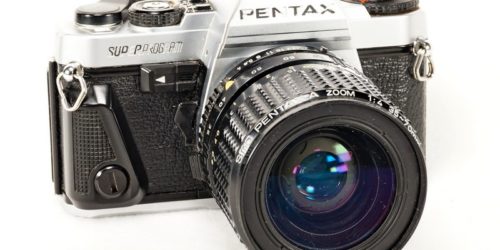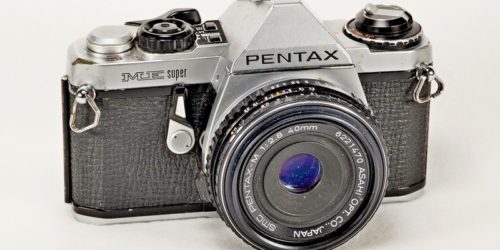Minolta Hi-Matic 7 S
Minolta Hi-Matic 7 s
Minolta used several naming conventions for the Hi-Matic cameras. The first camera was just a Hi-Matic, as with Canon’s first Canonet, which branched to other numbered models. It was followed by the Hi-Matic 7, then 7s, and later the 9 and the 11. The Hi-Matic 5 was introduced in 1969, a model exclusive to JCPenney stores. Together with the 11 came the High-Matic C, and the models thereafter used the alphabet as naming conventions. I would classify the early, metal-bodied Hi-Matics as the classic models. See the full Hi-Matic lineup here.
So, the manual 7 of 1963 was the second model in this line, closely followed in 1966 by the 7s, which added some features, including auto mode. The 7s II came much later, in 1977, equipped with a faster 1.7/40 lens. The 7s II was also rebranded as the Konica Auto S3, Revue 400SE, Prinz 35-ER, and Vivitar 35ES, and is rumoured to have been made by Cosina. The 9 was a 7s with a faster lens, added slow speeds, and a battery check function. The 11 was a 9 with an easy flash feature.
The High-Matic line was among the most popular mid-market cameras, with a remarkable number of online articles, similar to the all-time favourites Canon AE-1 and Pentax K1000.
Holding the 7s may explain its popularity. It is solid, very well made and finished, with an easy-to-use interface and a short learning curve. Aside from its weight, it can easily pass as a current, modern model. Minolta added features dubbed CLC and SLS, see notes below.
- The camera has an all-metal body, which is reflected in its weight. Nonetheless, it is well-balanced in the hand.
- The top has the lever winder, a self-resetting frame counter, a hot shoe, and fold-up rewind crank handle.
- The winder lever travel is long, from back to front. It can either be wound in one stroke or several passes. Winder pulls the film and cocks the shutter.
- The meter needle is positioned within the viewer, on the right, indicating an EV scale as well as over- or underexposure.
- The viewer is large and bright, with good, live parallax marks but a faint patch.
- Back has a slot marked ‘film’ with an arrow. A red mark moves with frame winding. I assume this is what Minolta meant by the SLS – Safe Loading System’ feature.
- The battery cover is at the bottom. The original battery was a #625 mercury cell, 1.35V. Not available anymore, alternatives are either the hearing aid zinc air #625, which lasts about a week once activated, or a more expensive #675, which is available online.
- The battery is for the meter only. The camera can be used in manual mode without a battery.
- The back opens by pulling a tab at the side.
- Inside are the cartridge chamber, a machined film path, dual cogs to keep the film correctly paced, and a good-sized take-off spool. On the back are a roller to guide the film and a pressure plate.
- The lens barrel holds the settings:
- Closest to the body is the focusing ring, which offers good length travel, making focusing easy.
- The next static ring carries the self-timer fin, marked ‘V’, and the sync port.
- In front of it is the aperture setting dial, and thereafter the shutter speed dial.
- A window in the aperture setting dial displays the EV, to be set according to the recommended value in the viewer.
- At the bottom of the lens barrel is the film speed selector.
- An ‘Off’ position disconnects the battery to preserve power. All it does is position a paddle in front of the meter lens. If used, remember to set the film speed again. The same effect can be achieved by mounting the lens cover.
- The light meter lens is at the front, just above the lens.
- The camera has a Minolta-branded feature, CLC – ‘contrast light compensator’, which is meant to register deep contrast in the subject’s lighting conditions. It is marked CLC by the meter lens. The concept is borrowed from some Minolta SLR models, which use two meter cells. There is a single meter lens, but it appears to be horizontally split, possibly having a double measuring feature.
To shoot, set the two dials to A against the white chevron in front of them, so the camera falls into automatic program mode. Otherwise, set the shutter and aperture dials combination to the recommended EV recommended by the meter needle in the viewer. Both dials are coupled together, so the EV will be retained once the f-stop is changed. To release the dials from the ‘A’ mode, press the tab at the right of the shutter speed dial.
For the collector, it is a fine mid-1960s camera to add to any collection. For a user, a fully working unit is an able shooter with all that is needed for casual photography. This model is widely available, although asking prices are a seesaw. Fully functional units are easy to come by, just make sure you ask before buying.
| Camdex list number | 5327 |
| Brand | Minolta |
| Model | Hi-Matic 7 S |
| Manual | Butkus |
| Value | Chrome Black |
| Format | 35mm |
| Introduced | 1966 |
| AKA | |
| Country | Japan |
| Qty made | |
| Initial price | 95 |
| Currency | USD |
| Type | Rangefinder |
| Body material | Metal |
| Mode | Manual, Auto |
| Weight | 750 gr, Body with lens |
| Class average weight | 640 gr, Body with lens |
| ASA range | 25-800 |
| Kit lens | 1.8/45 |
| Lens make | Rokkor |
| Filter size | 55 mm |
| Lens mount | Fixed lens |
| Mount size | N/A |
| Aperture | |
| Shutter | Leaf |
| Shutter make | Seikosha LA |
| Trigger | On top |
| Winder | Lever |
| Shutter cocking | Winder |
| Light meter | Selenium, external, coupled |
| Loc | No |
| Speeds | B, 4-500 |
| Mirror | N/A |
| Viewer | Coupled rangefinder |
| DOF preview | No |
| Exposure lock | No |
| Exposure compensation | No |
| Shoe | Hot |
| External sync | X |
| Timer | Yes, mechanical |
| Battery, original | 625 |
| Sync speed | 30 |
| Battery, replacement | 675 |
| Battery voltage | 1.35 |
| Integral flash | None |
| Other | |
| More | Rokkor Files Asser Stadsfotograaf 35mmc 678 Vintage cameras Matt’s Classic Cameras |
| Service / repair links | See camerlog.com |











